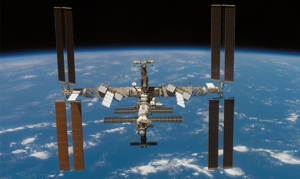This is one of the coolest videos I’ve seen in a while: during a routine reboost of the International Space Station to a higher orbit, the astronauts on board show that the station tries to leave them behind!
What a fantastic example of Newtons’s First law: an object in motion tends to stay in motion unless acted upon by an outside force. As the ISS circles the Earth, all the forces on it are balanced. You can think of it this way: the force of gravity pulling it toward the Earth is balanced by the centrifugal force (or the centripetal acceleration, which is equivalent*) outward. Because there are no leftover forces on the ISS, it feels like it’s in free fall, what some people call weightlessness. No force means no acceleration which means no weight.
 However, that’s not always the case. Even a few hundred kilometers up, there’s air. It’s thin, but over time it robs energy from the ISS, dropping it lower in its orbit. This is called drag, and it’s a very tiny force (too small to feel on board the ISS), but it adds up over time. To prevent the station from falling too far and burning up, every now and again low thrust rockets are used to push it up into a higher orbit.
However, that’s not always the case. Even a few hundred kilometers up, there’s air. It’s thin, but over time it robs energy from the ISS, dropping it lower in its orbit. This is called drag, and it’s a very tiny force (too small to feel on board the ISS), but it adds up over time. To prevent the station from falling too far and burning up, every now and again low thrust rockets are used to push it up into a higher orbit.
But that applies a force that is not balanced! While the rocket is firing, the ISS feels a force upwards. The astronauts inside, though, aren’t connected to the station unless they hold on. So they don’t feel that force. The station moves upward while their bodies stay on their individual orbits around the Earth. It’s only when they hit the back wall (or grab onto a handhold) that they feel the force from the rocket.
The camera is mounted on a bulkhead at the end of the ISS opposite the rocket, looking back “down” toward it. When the rocket fires, from the camera’s point of view the astronauts move away, “downward”. When they reach the end of that corridor, they grab on, climb back up, and fall again.
Think of it like this: imagine you’re in a car, with a camera on the dashboard facing you. When you hit the gas and accelerate forward, you feel like you’re being pushed back in your seat. What’s really happening is that the engine is pushing the car forward, leaving you behind. The seat then pushes on you, accelerating you along with the car. If the seat weren’t there, you’d fall to the back of the car – just like the astronauts on the ISS!
On the ISS, a rocket does the accelerating. On Earth, gravity does that job when you drop something. But on Earth, it would fall much more rapidly – 5 meters (about 16 feet) in the first second, 15 meters in the second, 25 in the third, and so on. But the rocket is far more gentle than Earth’s gravity; judging by the video, I initially guessed it was less than 1% of Earth’s gravity. I think that’s about right: if this was the reboost they did on October 26, then they accelerated at about 0.02 meters per second per second†, which is 1/500 of Earth’s gravity. Not much, but enough to see!
And enough to move the station. The thrust was held for nearly two minutes, which was enough to boost the ISS about 3.2 km (2 miles) higher than it was. Not a huge amount, but enough to extend its life for quite some time.
Physics! It’s not only cool, it can also save your $100 billion science project.
Tip o’ spacesuit visor the Burt Humburg. Image and video credit: NASA.
* Yes, they are equivalent. Just to be sure, I’ll link to this again. If you don’t read that before leaving a comment telling me there’s no such thing as centrifugal force, then you are granting me tacit permission to make fun of you.
† For you math and physics dorks out there, they changed their velocity by about 1.8 meters per second over 114 seconds. That’s an acceleration of 1.8/114 = 0.016 m/sec/sec. Earth’s gravity is an acceleration of 9.8 m/sec/sec, so the ratio is about 0.0016. I rounded a bit in the numbers in the main text.